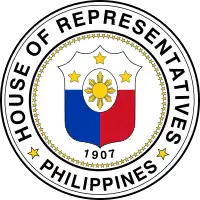Maximino Noel
Maximino Jaen Noel (May 29, 1879 – July 6, 1969) was a Filipino Visayan politician and the longest-serving congressman from Cebu, Philippines. Representing Cebu's old 3rd legislative district, he was a member of the Philippine Legislature (1928–1934), National Assembly (1939–1941), Congress of the Commonwealth (1941-1946), and Congress of the Republic (1946–1949, 1954–1961, 1962–1965).
Maximino Jaen Noel | |
|---|---|
| Member of the Provincial Board of Cebu | |
| In office 1922–1925 | |
| Member of the Philippine Legislature | |
| In office 1928–1934 | |
| Member of the 2nd National Assembly | |
| In office 1939–1941 | |
| Member of the Congress of the Commonwealth | |
| In office 1945–1946 | |
| Member of the Congress of the Republic | |
| In office 1946–1949 | |
| In office 1952–1965 | |
| Personal details | |
| Born | May 29, 1879 Carcar, Cebu, Philippines |
| Died | July 6, 1969 |
| Nationality | Filipino |
| Political party | Nacionalista Party |
| Alma mater | Liceo de Manila |
Early life and education
Maximino Noel was born to parents Florencio Mercado Noel and Filomena Jaen in Carcar, Cebu[1] on May 29, 1879.[2] His father was the first municipal president (equivalent of mayor) of Carcar, and so was his brothers Vicente and Mariano who succeeded his father.[1] He attended Liceo de Manila and took up Commerce.[3] The ancestral house of the Noel family built in the mid-19th century was proclaimed a heritage house by Ambeth R. Ocampo, chairman of the National Historical Commission of the Philippines in May of 2010.[4]
Career
Maximino, planter and businessman,[5] was voted councilor in his hometown of Carcar, Cebu.[3] Then he replaced Mariano when he was elected as mayor of Carcar in 1916[1] and served for six years.[3] From 1922 to 1925, he became a member of the Cebu Provincial Board.[6]
He was considered the longest-serving Congressman due to the length of his tenure representing Cebu's old 3rd legislative district, which was composed then of the municipalities of Talisay, Minglanilla, Naga, San Fernando, and Carcar. He was elected as member of the Philippine Legislature in 1928–1931.[1][7] Vicente Rama, his political rival to the position, published in his newspaper Bag-ong Kusog the story entitled Si Amar ug si Leon (Amar and Leon). Scholars believed the hero, Amar, represented Rama and the villain Leon, the political rival Noel.[8] The exhumation of the remains of Leon Kilat, who was betrayed and killed in Carcar at the height of the Philippine Revolution, was also made into a political issue during that election.[9]
Before World War II, he was one of the stockholders and original member of the Board of Directors of the now defunct National Rice and Corn Corporation by virtue of the executive order issued by then President Manuel L. Quezon.[10]
In 1931–1934, he would again serve for another term and then reelected in 1938–1941. In 1941, he was voted again to the same office but served only in 1945 because of the outbreak of World War II. Moreover, he was voted to the same office in 1946–1949.[1][7]
In the 1949 elections, he was defeated by Primitivo Sato. However, Sato did not finish his term and was unseated as the House Electoral Tribunal ruled in favor of Maximino Noel's electoral protest[11] that was promulgated by Enrique Medina in Electoral Case No. 42 on November 22, 1952.[12]
He again won in the same elective post under Nacionalista Party in 1954–1957, 1958–1961, and 1961–1965.[1][7] During his term in Congress, he was a member of the Commission on Appointments, Vice Chairman of the Committee on Internal Government and Privileges, and a member of the Committee on Accounts.[3]
Historical commemoration
- The Rep. Maximino Noel (Guadalupe) National High School in Valladolid, Carcar, Cebu was named in his honor by virtue of Republic Act No. 8638 which was enacted on May 17, 1998.[13]
- The Noel Boulevard in Talisay City, Cebu was also named after him by virtue of Municipal Council Resolution No. 70-89.[1]
References
- Oaminal, Clarence Paul (October 23, 2013). "Noel Boulevard, Talisay City, Cebu". www.pressreader.com. The Freeman through Pressreader. Retrieved 2019-05-19.
- Mojares, Resil B. "Today in the History of Cebu" (PDF). www.library.usc.edu.ph/. University of San Carlos. Retrieved May 19, 2019.
- Representatives, Philippines Congress (1940-1973) House of (1955). Official Directory. Bureau of Printing.
- "Carcar houses declared historical sites". Sunstar. 2010-05-29. Retrieved 2019-05-19.
- Simbulan, Dante C. (2005). The Modern Principalia: The Historical Evolution of the Philippine Ruling Oligarchy. UP Press. ISBN 9789715424967.
- Mojares, Resil B. The history of Cebu, Philippines. Cebu (Philippines : Province),, University of San Carlos. Cebu City. ISBN 9789719972235. OCLC 953176470.
- "ROSTER OF PHILIPPINE LEGISLATORS". www.congress.gov.ph. House of Representatives; Republic of the Philippines. Retrieved May 19, 2019.
- Journalism, Cebu; Journalists (2015-09-24). "Bias and the future of journalism". Cebu Journalism & Journalists. Retrieved 2019-05-19.
- Bersales, Jobers. "Exhuming Leon Kilat". newsinfo.inquirer.net. Retrieved 2019-05-19.
- Information, Philippines Office of Public (1950). Republic of the Philippines Government Manual. Bureau of Printing.
- Oaminal, Clarence Paul (August 28, 2015). "Congressman Primitivo Sato". www.pressreader.com. The Freeman through Pressreader. Retrieved May 19, 2019.
- Sidel, John Thayer (1999). Capital, Coercion, and Crime: Bossism in the Philippines. Stanford University Press. ISBN 9780804737463.
- Juris, The Corpus (1998-05-17). "R.A. No. 8638: An Act Separating the Valladolid National High School Extension in the Municipality of Carcar, Province of Cebu, from the Valladolid National High School and Converting it into an Independent National High School, to be Known as the Rep. Maximino Noel (Guadalupe) National High School, and Appropriating Funds Therefor". The Corpus Juris. Retrieved 2019-05-19.
